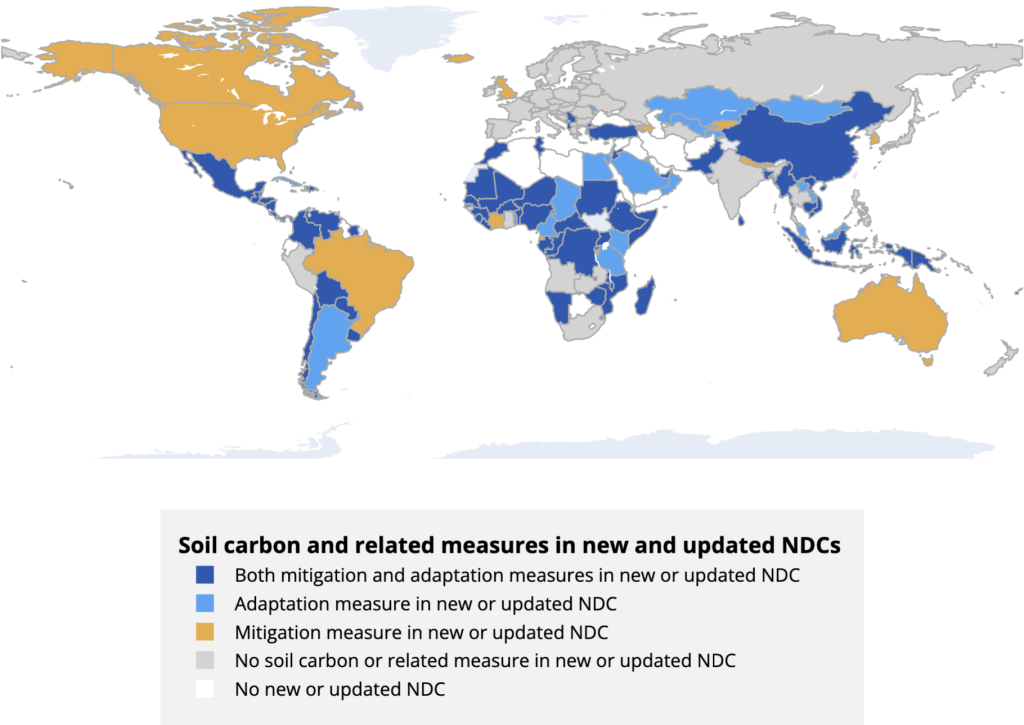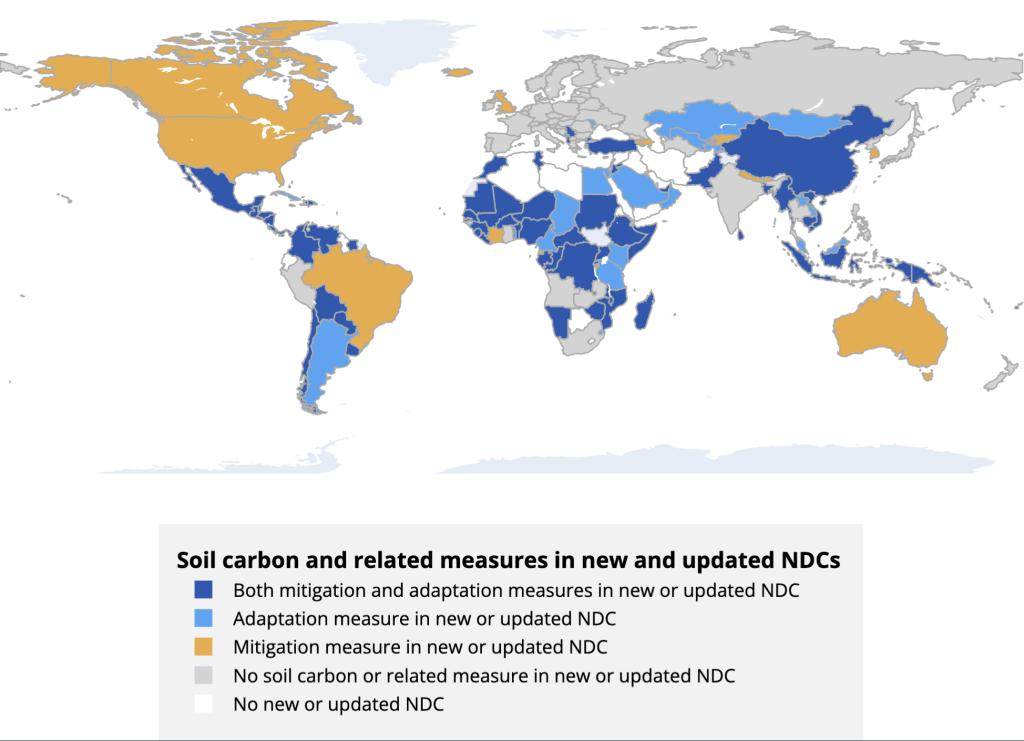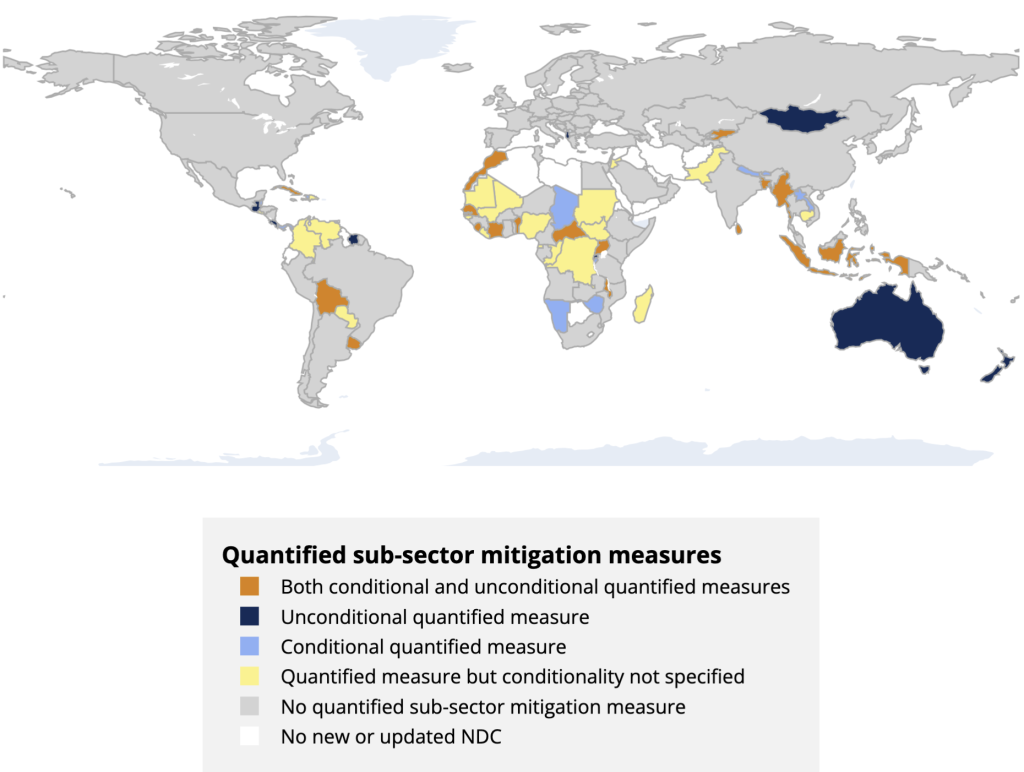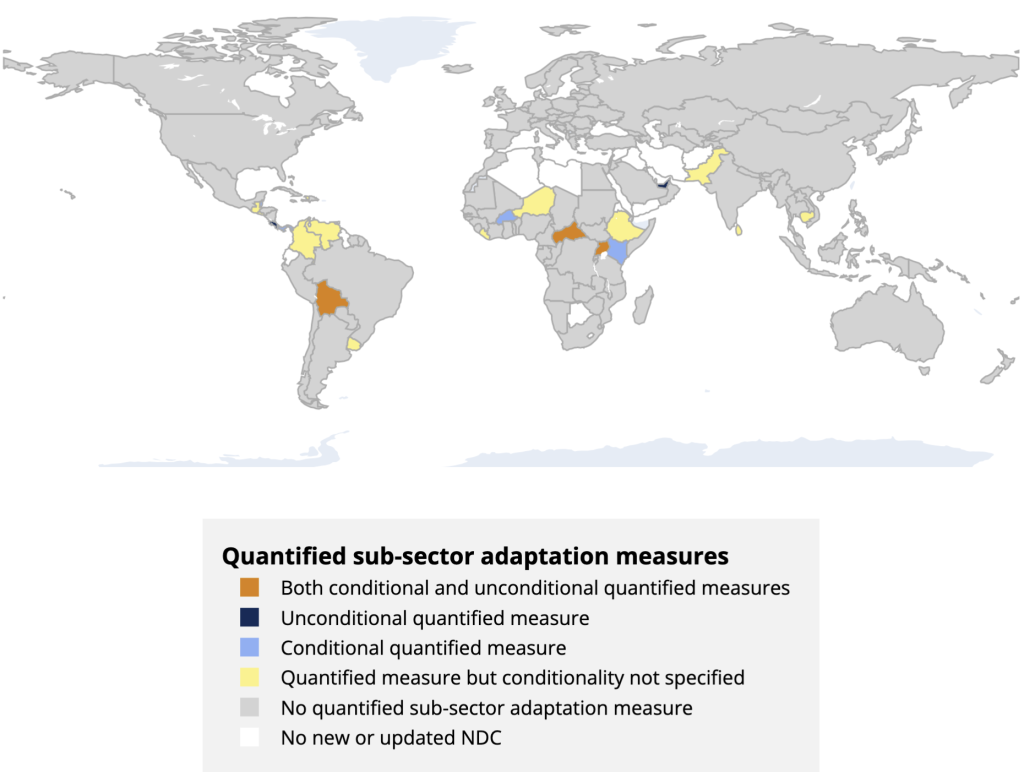Agriculture sub-sectors in the NDCs: 2020-2024 Data & maps
A review of countries' 2020-November 2024 commitments to climate change mitigation and adaptation shows increasing ambition in agriculture sub-sectors, but it isn’t yet enough to reach Paris Agreement global targets.
Download the 2024 NDC database here
Countries were asked to submit pledges, called Nationally Determined Contributions (NDCs), for climate action that they would take under international agreement agreed upon at the Conference of the Parties to the United Nations Framework Convention on Climate Change (UNFCCC) in Paris in 2015 (COP 21). As of November 30, 2024, the cutoff date for this analysis, 149 NDCs had been submitted, representing the contributions of 176 countries (the European Union submitted a single updated NDC representing all 27 member countries). These NDCs form the foundation for implementing the Paris Agreement, with revisions every five years and the expectation of increasing ambition of mitigation contributions.
CCAFS reviewed the latest round of NDCs (2020-November 2024) with an eye toward what they mean for agriculture and how sub-sectors are addressed: What countries included agricultural sub-sectors in their mitigation and adaptation plans? What countries quantified goals for agricultural sub-sectors? What practices did they prioritize for implementing those plans? How much financial support may be necessary for implementation?
Results
Sub-sector mitigation or adaptation measures
Some NDCs provided information on particular agricultural sub-sectors and measures (policies and actions) that countries plan on prioritizing for mitigation or adaptation. Mention of common soil organic carbon, livestock, and rice sub-sectors and activities measures is illustrated in the maps below. This analysis focuses on the specification of the sub-sector commitments in the NDCs as a measure of transparency. Countries that included soil organic carbon, livestock, or rice implicitly within economy-wide or sectoral measures (e.g., agriculture, energy) are not accounted for in this analysis.
Detailed agricultural sub-sector analysis of progress since the first NDCs, level of ambition, comparison of ambition and emissions reduction potentials from sub-sectors, support for implementing domestic policies, and investment needs can help enhance the clarity, transparency, and understanding needed to support NDC progress. Sub-sector analysis can identify gaps in mitigation targets, finance needs and policy.
The analysis can also track NDC progress to assess adequacy toward meeting targets in the sub-sector. Global and national agricultural development organizations, climate finance entities, and others in the agriculture sector can use this information to make more informed investment decisions. The livestock sector, as the largest contributor to agricultural emissions, soil carbon management, as the largest contributor to carbon removal, and rice cultivation, as a sub-sector with high potential for mitigation, are priorities.
Please note that the info notes have only been updated through September 2022 and have not been updated with the 2024 data. The maps and analysis below are consistent with the 2024 data.
Soil organic carbon
One hundred eighteen (118) out of 176 countries (67%) referred to soil carbon explicitly (37 countries) or soil carbon-related practices (81 countries) in the new and updated NDCs. See the database for a list of soil carbon-related practices. Countries that mentioned soil carbon or related practices in mitigation contributions only (20 countries) are shown below in orange. Countries that mentioned soil carbon or related practices in adaptation contributions only (28 countries) are shown in blue. Countries that mentioned soil carbon or related practices in mitigation and adaptation contributions (70 countries) are in dark blue.
Mitigation priorities included agroforestry (28%), wetland management (27%), and grassland management (14%). Adaptation priorities similarly included wetland management (36%), agroforestry (26%) and grassland management (15%). Twenty-nine countries referred to soil organic carbon explicitly for the first time since the previous NDCs.

Livestock
Countries that mentioned livestock in mitigation contributions only (27 countries) are shown below in orange. Countries that mentioned livestock in adaptation contributions only (31 countries) are shown in blue. Countries that mentioned livestock in mitigation and adaptation contributions (41 countries) are in dark blue.
Mitigation priorities included manure management (22%), feed management (17%) and silvopastoralism (11%). Adaptation priorities included breed management (18%), silvopastoralism (10%) and feed management (10%). Thirty-five countries referred to livestock for the first time since the previous NDCs.

Rice
Countries that mentioned rice in mitigation contributions only (19 countries) are shown below in orange. Countries that mentioned rice in adaptation contributions only (8 countries) are shown in blue. Countries that mentioned rice in mitigation and adaptation contributions (14 countries) are in dark blue.
Mitigation priorities included water management (8%), land use and by-product management (6% each), and fertiliser management (5%). Adaptation priorities included water management (5%), variety development (5%), and System of Rice Intensification (SRI) (4%). Twenty-nine countries included rice for the first time since the previous NDCs.

mitigation measures with quantified indicators
To enhance clarity, transparency, and understanding of sub-sector commitments, countries quantified indicators in greenhouse gas (GHG) or non-greenhouse gas (non-GHG) units in NDCs. Where targets have specific GHG reduction goals over clear timelines, measures with quantified indicators may only track indicators in non-GHG units and may not specify timelines. Fifty-nine countries included mitigation measures with quantified indicators for soil carbon, livestock, or rice sub-sectors in the new and updated NDCs. Fifty-one countries used non-GHG units only. Specifying non-GHG actions (e.g., with hectares or percent area as indicators) in NDCs may provide flexibility for countries that cannot track GHG impacts but can track policies and actions.
Countries that included unconditional mitigation measures with quantified indicators for soil carbon, livestock, or rice (9 countries) are shown in dark blue. Countries that included quantified conditional mitigation measures (13 countries) are shown in light blue. Countries that included both quantified unconditional and conditional mitigation measures (16 countries) are shown in orange. Countries that included quantified mitigation measures but did not specify conditionality (21 countries) are shown in yellow.

Adaptation measures with quantified indicators
Twenty-six countries included quantified adaptation measures for soil carbon, livestock, or rice sub-sectors in the new and updated NDCs. Two countries included a quantified unconditional adaptation measure and is shown in dark blue. Countries that included quantified conditional adaptation measures (8 countries) are shown in light blue. Countries that included both quantified unconditional and conditional adaptation measures (3 countries) are shown in orange. Countries that included quantified adaptation measures but did not specify conditionality (13 countries) are shown in yellow.

Policies to implement soil organic carbon commitments
While the policy analysis has only examined the case of Brazil and Rwanda, the alignment of domestic policy and NDC commitments is a broader issue that will require attention for the implementation of climate pledges. Countries with national agricultural policies providing quantified SOC-related mitigation actions and commitments can increase NDC transparency by referring to such policies and associated actions in their NDCs.
To maintain flexibility for meeting NDC commitments while enhancing information, NDCs could at a minimum refer to domestic policies for implementation without necessarily committing to mitigation or adaptation outcomes.
In addition, NDC development can be a driver for national SOC-related projects, actions, commitments, mitigation potentials and MRV mechanisms. For developing countries, this process can be enhanced through support programs for NDC development. In countries where quantifying SOC-related agricultural actions is driven by NDC development, relevant agricultural policies need to be updated and aligned to support NDC implementation.
Gender
The latest NDCs show significantly greater recognition of the vulnerabilities, needs, and capacities of women and other marginalized groups. However, only 14% of developing country new or updated NDCs included gender-responsive indicators in the agricultural sectors.

Source: Crumpler K, FAO, 2021
Methodology
Mitigation or adaptation measures
A country was registered as prioritizing a measure if the NDC mentioned a keyword for agriculture sub-sectors within the NDC's mitigation or adaptation section, or if it was obviously in the bounds of mitigation or adaptation. Mentions of keywords within introductory sections were not counted if they were not followed by mentions of measures in future mitigation or adaptation plans.
We used a qualitative analysis software, NVivo, to search for keywords and categorize mentions of agricultural sub-sector mitigation and adaptation practices within the NDCs related to soil organic carbon, livestock management, and rice cultivation. NDCs in French and Spanish were analyzed using keywords translated into those languages. Countries that included soil organic carbon, livestock, or rice implicitly within economy-wide or sectoral measures (e.g., agriculture, energy) are not accounted for in this analysis.
Finance
Data on finance needs for agricultural sub-sector mitigation and adaptation measures were collected through analysis of the text using NVivo. The data collected for finance were specific to soil carbon, livestock, and rice measures and included: amount for climate change adaptation or mitigation, timeline, and conditionality, where specified. Finance needs that were aggregated for the agricultural sector are not accounted for in this analysis.
Download the database and methodology here
Other analyses of the NDCs |
|---|
In 2016, CCAFS conducted an analysis of the Intended Nationally Determined Contributions inclusion of agriculture adaptation and mitigation (maps & data). In 2019, another analysis of ambition for soil organic carbon protection and sequestration in the first round of NDCs was published (read the Info Note or journal article or read about the webinar on preliminary results). In 2022, another analysis of ambition for soil carbon, livestock, and rice sub-secotrs in the new and updated NDCs was published (see Box below). In 2024, an Official COP29 Side Event was held to present these findings along side partners and other analysis of the NDCs to call for more ambitious action to implement the NDCs. Find the presentations here. |
Agriculture's prominence in the INDCs: data and maps (2016 analysis) Countries’ commitments to SOC in NDCs (2019 analysis) Expert panel discussion of the 2021 NDC analysis (27 October 2021) Ambition for soil organic carbon sequestration in the 2020-22 NDCs |
Learn more about the FAO analysis of the latest NDCs Learn more about how the WRI Climate Watch NDC Tracker both informs and tracks NDC progress |
2024: This work was conducted by Kyle M. Dittmer, Research Analyst, Arun Khatri-Chhetri, former Science Officer, Sabrina Rose, former Policy consultant, and Milena Stier, former Research Assistant. Please contact Kyle Dittmer for more information (see database for contact information).
This work was led by Lini Wollenberg, Flagship leader for CCAFS Low-Emissions Development and conducted by Arun Khatri-Chhetri, former Science Officer, and Sabrina Rose, former Policy consultant, Kyle M. Dittmer, Research Analyst, and Milena Stier, Research Assistant for the CCAFS Low-Emissions Development Flagship. Kyle Dittmer, Research Analyst for CCAFS LED, updated the database in May 2022.
Acknowledgment
2024: This work is being implemented by CGIAR researchers from the Alliance of Bioversity & CIAT, in close collaboration with International Rice Research Institute (IRRI), International Livestock Research Institute (ILRI), World Agroforestry, Food and Agriculture Organization (FAO), and World Research Institute (WRI). This work was also supported by the US Agency for International Development (USAID). The views expressed in this document cannot be taken to reflect the official opinions of these organizations.
The analysis was carried out by CCAFS, ILRI and IRRI in collaboration with the FAO and WRI Climate Watch. In addition to CCAFS donors, the U.S. Agency for International Development (USAID) supported the publication of the data and maps on this page. The opinions expressed herein are those of the author(s) and do not necessarily reflect the views of USAID.